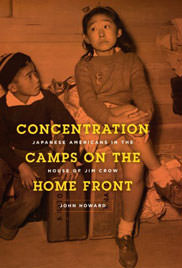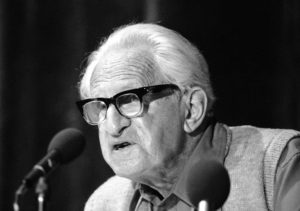Jay Feldman on ‘Concentration Camps on the Home Front’
A revelatory account of a hidden chapter of the treatment of Japanese-Americans during World War II deepens our understanding of American prejudice and the abuse of power.
By now, the forced relocation and internment of between 110,000 and 120,000 West Coast Japanese-Americans by the War Relocation Authority during World War II have been well documented. This egregious violation of civil liberties has been grudgingly accorded a place in our schoolbooks, but there is much about the subject that is still not fully understood or even acknowledged.
In “Concentration Camps on the Home Front,” a study of the two WRA camps in Arkansas, John Howard addresses a number of these misunderstandings and gaps. Using a methodology that combines “feminist scholarship, critical race studies, and socioeconomic analysis in a Marxist tradition” and further draws on “developments in queer theory,” Howard — an openly gay expatriate Southerner who is now head of the American studies department at King’s College London — shines a light on several heretofore unexplored areas of the Japanese-American experience during WWII.
First and foremost, of course, there is the profound irony, spelled out in the book’s subtitle, of Japanese-Americans being interned in the Jim Crow South. “We are constantly striving to keep the people in this region from treating the evacuees as they treat Negroes,” said one WRA official, it apparently never having occurred to this apparatchik that the government itself had already turned Japanese-Americans into second-class citizens.
Employing the more current terminology — concentration camp rather than internment camp, and incarceration rather than internment — Howard also plausibly argues that the displacement, imprisonment and postwar resettlement of Japanese-Americans constituted a deliberate attempt on the part of the U.S. government to disperse the Nikkei community, to “Americanize” and “Christianize” its members and to decrease their geographical proximity to Japan.
Why else would President Franklin Roosevelt suppress the report by State Department representative Curtis Munson, which the president himself had commissioned in fall 1941 to investigate the Japanese “problem” on the West Coast? In his report to Roosevelt a month before Pearl Harbor, Munson clearly stated, “There is no Japanese ‘problem’ on the Coast.” At the same time that Munson was conducting his study, U.S. Navy Lt. Cmdr. Kenneth Ringle, who spoke Japanese and was well known in the Los Angeles Japanese-American community, was carrying out a similar investigation for the Office of Naval Intelligence. Ringle’s report, submitted six weeks after Pearl Harbor, concluded that “The entire ‘Japanese Problem’ has been magnified out of its true proportion, largely because of the physical characteristics of the people. It should be handled on the basis of the individual, regardless of citizenship, and not on a racial basis.”
In the camps a massive attempt was undertaken, as Howard wryly notes, to ” ‘rehabilitate’ a group wrongly imprisoned in the first place.” As the editor of Community School Forum, a Washington publication for educators in the camp schools, bluntly wrote, “Here is an opportunity to carry on a magnificent job of Americanization.” By extension, Americanization meant Christianization, and camp administrators showed blatant favoritism to Japanese-American Christian organizations and churches over Buddhist groups and temples. And when the time came to close the camps, Roosevelt advocated “a gradual release program designed to scatter the internees” so that they would not re-establish their pre-war “Little Tokyos.” Howard astutely discerns that “the guiding principle of dispersing Japanese Americans remained a cornerstone of resettlement policy.”
Another area that Howard illuminates is the role of women in the camps, where conditions necessarily upended traditional gender roles. Because the one-room camp dwellings required far less cleaning time, and the communal dining halls, with their paid cooks and servers, essentially eliminated the preparation of nuclear-family meals, there was a drastic reduction in women’s domestic responsibilities, which left them free to pursue other activities. For the first time, many Japanese-American women took on jobs outside the home and became wage earners in clerical, administrative and professional positions, which changed the hierarchical structure of the previously strongly patriarchal Japanese-American family — a fundamental change that carried over into the postwar period, as Japanese-American women found new opportunities and independence, both personal and financial.
Howard also highlights the acts of resistance in the two Arkansas camps, in order to refute the picture, painted by many historians of the internment, of the Japanese-American community as passive and accepting of its fate. The woodcutters’ strike of December 1942 in the Jerome camp was a reaction to brutal and exploitative working conditions; it resulted in the firing of the members of six crews, who then became organizers, instituting a workers’ education campaign and forming a local labor movement within the camp. The Jerome motor repair shop strike of spring 1943 was a protest against the firing of two Japanese-American foremen without cause, and actually brought about concessions from the camp’s management. The ill-fated Jerome general strike of October ’43 reveals a committed group of labor organizers, who secretly drafted and mimeographed a call to arms which, despite its radical language, was eminently reasonable in its demands. Borrowing an old tactic of the Wobblies, the leaflets were left in the men’s communal toilets — the one place where management would never go. That the general strike failed to materialize does not negate the rebelliousness of the effort.
For all its virtues, “Concentration Camps on the Home Front” suffers from a lack of focus. It begins and ends, for example, with the story of Earl Finch, a closeted gay Southern businessman who became a selfless benefactor to Japanese-American soldiers and, after the war, to Japanese-Hawaiians. Interesting though it is, however, and though it frames the book, the Earl Finch story is only tangentially related to the story of the Arkansas camps. Similarly, the book’s themes are not especially smoothly woven together, and while Howard’s expressed aim is to “construct a thorough social history, accessible to both academic and popular readerships,” “Concentration Camps on the Home Front” is first and foremost an academic study, and most likely to find its audience in that sector.Moreover, Howard makes a glaring error of omission common to virtually the entire body of literature on the Japanese-American relocation and internment: By failing to connect the War Relocation Authority program to its antecedent, the Justice Department’s Alien Enemy Control program, he perpetuates the widespread misconception that Japanese-Americans were the only U.S. group targeted during the Second World War.
In fact, the WRA program, rather than having sprung independent and full-blown — as it is almost universally perceived to have done — was a natural and direct outgrowth of the Alien Enemy Control program. By the time the WRA plan was conceived and carried out beginning in February 1942, the assault on civil liberties had already been under way for five years, tracing back to an August 1936 meeting between President Roosevelt and FBI Director J. Edgar Hoover, in which FDR asked Hoover to undertake a secret FBI investigation of “subversive” activities in the United States.
Starting on the very day of the Japanese attack on Pearl Harbor, the FBI, on the basis of the investigations initiated in August 1936, carried out a haphazard, almost entirely unnecessary and largely ineffective roundup of Japanese-, German- and Italian-Americans, a number of whom were U.S. citizens. Within 48 hours after Pearl Harbor, nearly 2,000 individuals had been apprehended. Along with a very small percentage of hard-core Nazis and Japanese spies and saboteurs, thousands of innocent people were swept up and sent to Department of Justice internment camps for years, with barely a passing nod to due process. In all, 8,004 Japanese-Americans, 6,847 German-Americans and 2,991 Italian-Americans were taken into “custodial detention” and shipped to more than a dozen Department of Justice camps throughout the country, and in some cases they were held long after the end of the war. Hundreds of others were “repatriated” to Germany and Japan in prisoner-of-war exchanges, among them many U.S.-born children — American citizens — who were sent “home” with their immigrant parents. In the end, not a single person arrested and interned under the Alien Enemy Control program was convicted of committing a war-associated crime against this country.
Simultaneously, in flagrant violation of international law, the United States conspired with the governments of more than 15 Latin American countries to identify, arrest and deport to the United States, with little or no evidence and no legal proceedings, more than 6,500 Latin Americans of German, Japanese and Italian ancestry. The deportees consisted of both immigrant residents and citizens of those Latin American countries from which they were deported. As with the domestic effort, the Latin American prisoners included only a small percentage of Nazis and Nazi sympathizers; unlike the domestic internees, they included virtually no dangerous Japanese. From Latin America, 4,058 Germans (including 81 Jews, some of whom had spent time in Nazi concentration camps), 2,264 Japanese and 287 Italians were taken from their homes and shipped to this country. The program was carried out by the State Department, but when the deportees reached the United States, they were classified as enemy aliens and interned in the Justice Department camps under the Alien Enemy Control program, alongside the domestic enemy aliens. Many of these Latin Americans were also used for POW exchanges with the Axis powers.
While Howard makes several mentions of the DOJ camps in “Concentration Camps on the Home Front,” he never explains their existence or draws the crucial distinction between them and the WRA camps, nor does he mention the internment of German and Italian-Americans or of German, Italian and Japanese Latin Americans.
Howard also concurs with the prevailing view of the Japanese-American relocation and internment as having been based entirely on racism. While racism was clearly and undeniably a key motivating factor, it is not the entire explanation. A fuller picture emerges only when the Japanese-American situation is seen in the full context of the other alien enemy groups’ internments. A cloud of suspicion hung over all three communities, based in large part on the assumption and fear that aliens’ loyalties were automatically divided between the United States and their countries of origin, and therefore their allegiance to this country was questionable, regardless of how long they had lived here. The nativist streak of resentment toward immigrants that had been an undercurrent in American life since the early 19th century cannot be overlooked in attempting to understand the internment of all three ethnic groups.
Still, despite these oversights, there is much to praise in Howard’s book. At its core, “Concentration Camps on the Home Front” holds up a critical lens to American society and values, raising such hot-button issues as race, family, gender politics, capitalism, individualism, immigration and nationalism. As such, it is a valuable contribution to the scholarship of the Japanese-American relocation and internment.
Jay Feldman is the author of “When the Mississippi Ran Backwards” (Free Press, 2005). He is currently working on a book for Pantheon about the scapegoating of minorities in times of crisis.
Your support matters…Independent journalism is under threat and overshadowed by heavily funded mainstream media.
You can help level the playing field. Become a member.
Your tax-deductible contribution keeps us digging beneath the headlines to give you thought-provoking, investigative reporting and analysis that unearths what's really happening- without compromise.
Give today to support our courageous, independent journalists.







You need to be a supporter to comment.
There are currently no responses to this article.
Be the first to respond.